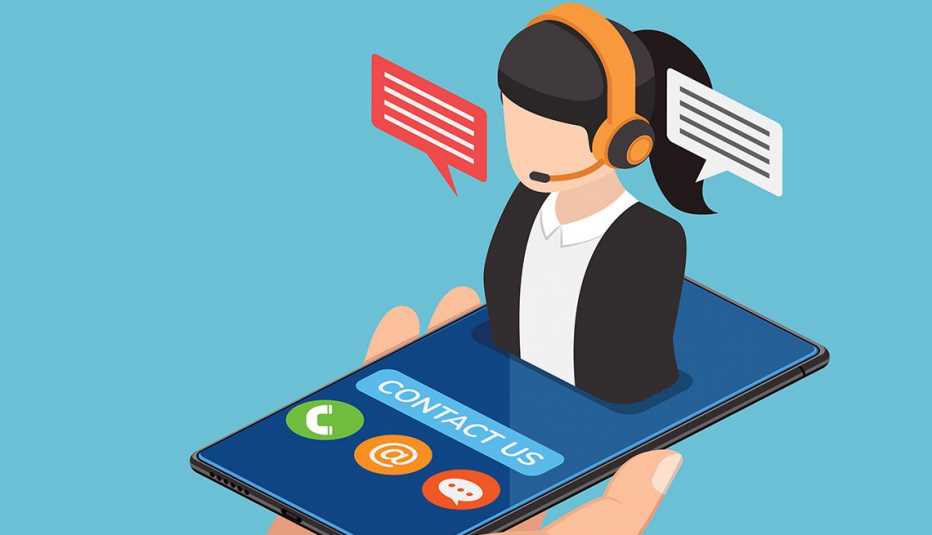Staying Fit
As technology advances and companies look to cut costs, fewer customer-service inquiries are handled by real people. Consider this the rise of the robot representative. But don’t fear. None of this means you need to avoid working with these tools. You just need to know how to use them to get the best service.


AARP Membership— $12 for your first year when you sign up for Automatic Renewal
Get instant access to members-only products and hundreds of discounts, a free second membership, and a subscription to AARP the Magazine.
Do you need human intervention anymore?
Try to reach a live customer-service representative lately? Chances are you found yourself funneled instead to an FAQs page, automated call system or online forum with troubleshooting advice. Basically, you’re being asked to use existing digital resources to solve the problem yourself. The reason for this is simple — money. Building digital tools and resource guides, even when sophisticated, is still cheaper than paying teams of customer-service representatives. “In some cases, companies are deliberately making it harder to speak with someone,” says Michelle Kinch Shell, a visiting scholar at Harvard Business School who has studied behavioral operations management.
This isn’t as bad as it sounds. Digital resources have gotten much better. And they allow companies to provide assistance around the clock. “Well-designed FAQs pages, customer forums and automated phone systems really do help,” says Jacob Hartog, a tech entrepreneur who’s done product management for mobile banking and telehealth applications. “And, in many cases, more quickly than speaking to someone on the phone.”
Many customer issues are common with easy-to-solve questions like how to reset a password, find a specific form, make simple modifications to a smartphone, get a replacement card, or restart a device. “From that point of view, it makes sense to use technology to automate repetitive tasks,” Hartog says. And after becoming familiar with these systems, many prefer them to live agents standing by. “Customers continue to demand these better, faster, more flexible ways of communicating,” says Lisa Kant, vice president of product marketing at Zendesk, a customer-service platform. “And traditional channels like voice, email or in-person service just aren’t enough.”
Many companies are even beginning to offer support on social media platforms like Instagram, Facebook and WhatsApp. With no wait times and no need to search for a phone number or to wait on hold, “it’s convenient,” Kant says. But self-service isn’t appropriate for all matters, especially stressful ones. “When people are anxious, they crave human contact,” says Shell, citing research she conducted at Harvard Business School. For tasks where self-service won’t cut it — or if you simply prefer speaking with a real representative — there is not always a simple solution. “Companies are not consistent with it,” Shell says. Some still provide call centers or on-site troubleshooting, while others don’t. And even when you manage to find that phone number? The wait may be long. “Getting access to a human agent is an effort in patience,” Shell says.
One tip is to research a company’s customer-service reputation before you buy. Check out Yelp reviews, Better Business Bureau ratings and social media comments. “Whether self-service, a help center, a chat, a mobile app or a phone is your preference, you really want to look for brands that are going to walk the walk,” Kant says.
How do those chatbots work?
Visit a website for a car dealership, insurance company or retailer, and you may see a pop-up window asking if you’d like to chat. Or if you’re seeking specific customer service — information about a specific product or shipping details — you may get sent to an instant messaging platform. In those cases, you’re probably not typing back and forth with a human, but with a chatbot, a form of artificial intelligence that can process your question, access information like your purchase history and shoot back an answer.
As machine learning improves and chatbots’ language increasingly resembles that of humans, many companies are deploying them to offer instant customer service, answer common questions and even help make sales. “In recent years, chatbots have become a lot more sophisticated in terms of the range of inputs that people can provide to them and the kinds of responses that they can come back with,” says Timothy Bickmore, a computer science professor at Northeastern University in Boston who studies human-and-computer interaction.
There certainly are advantages to chatbots over customer-service phone centers. There’s no waiting on hold. And if you have an account with that business and are already logged in on your computer, the bot will have your information at the ready. “Those things can reduce the friction of that entire experience,” says Hartog. What’s more, chatbots are consistent. “They give uniform responses,” Bickmore says. “You’re talking with something that doesn’t have a bad day.” Want to look up details about an order? Find operating hours? Learn about new promotions? Bots can be the easiest route, Kant says. Just type in your question. “As a consumer, you just want to get that answer and move on with your day,” she says. “That is the kind of an issue of transaction that a bot or an automated experience is perfect for.” But chatbots aren’t well-suited for every task.



































































